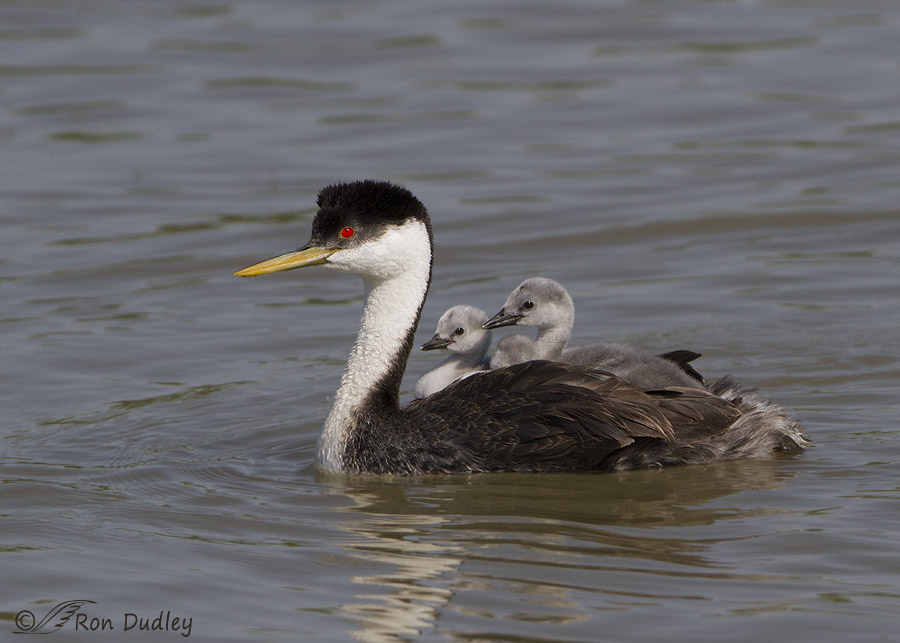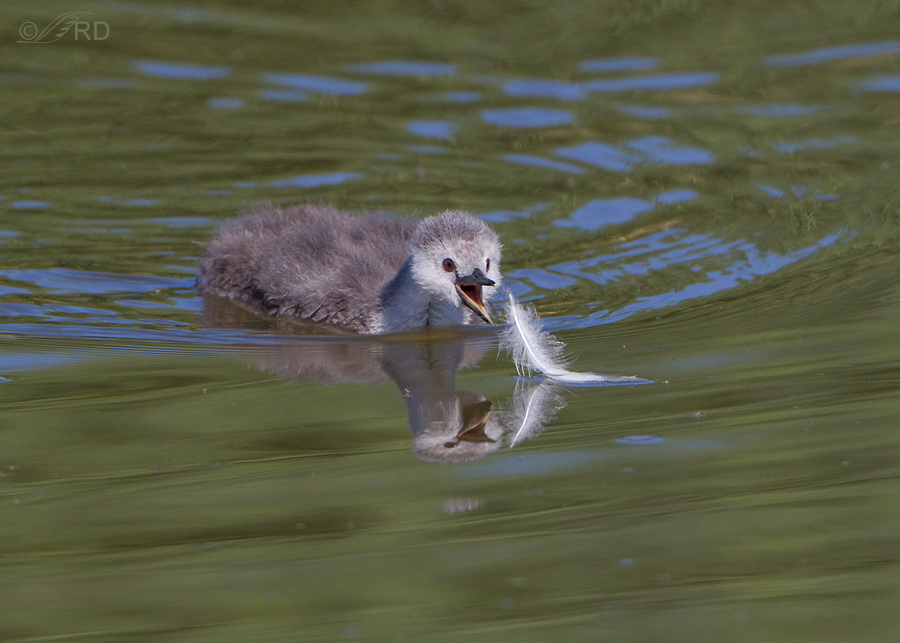Category: Clark’s Grebes
Grebes Eating Feathers (including two graphic images)
Western And Clark’s Grebes – A Comparison
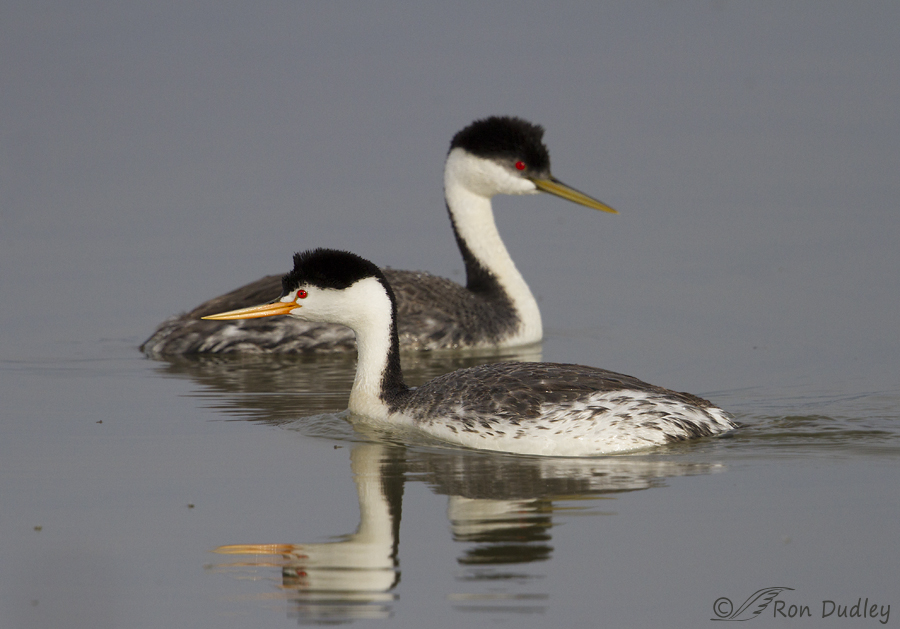
Western Grebes and Clark’s Grebes are so similar in plumage patterns and behaviors that until 1985 they were considered to be color phases of the same species – the Western Grebe. In fact they’re similar enough that many observers never even recognize Clark’s Grebes when they see them and assume that they’re the more common Western Grebe.
Ratchet pointing, Dip-shaking Western Grebes
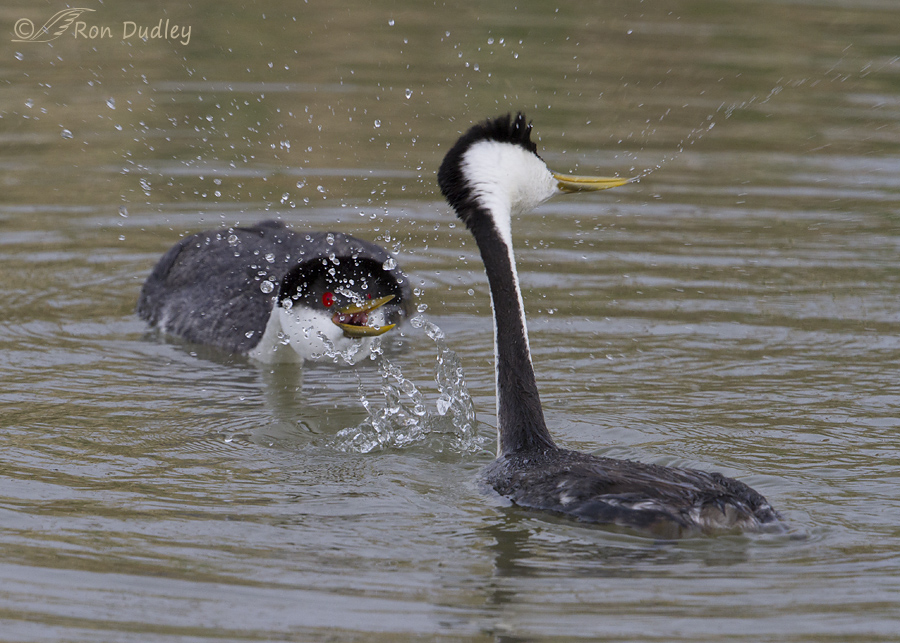
Two behaviors indicative of pair bonds between mated pairs of Western (or Clark’s) Grebes are “Ratchet pointing” and “Dip-shaking”. The behaviors are often alternated, one after the other. I photographed both of them as they were performed by a pair of Western Grebes three days ago at Bear River Migratory Bird Refuge.
Clark’s Grebe Blowin’ In The Wind
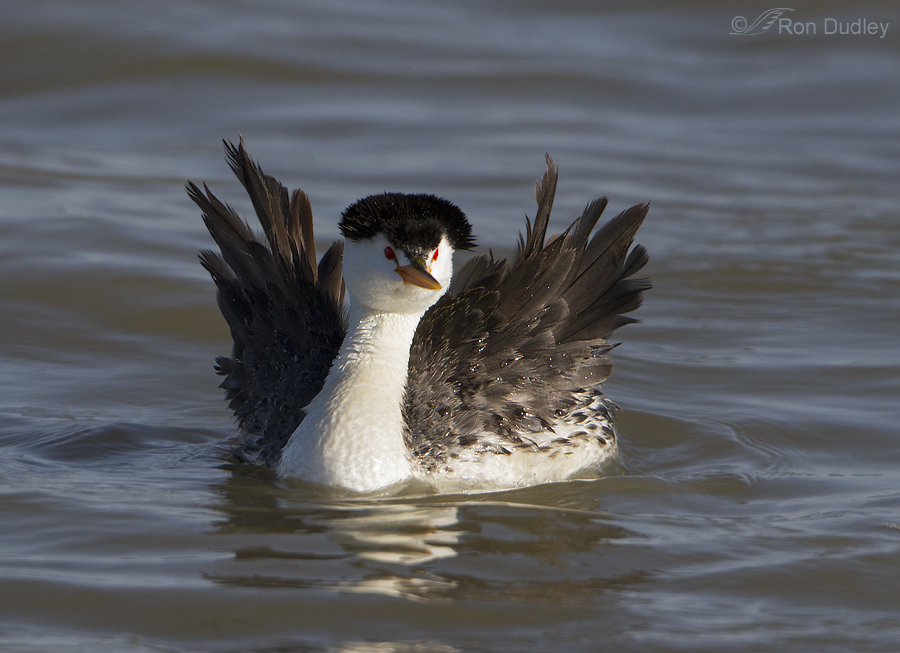
Three days ago at Bear River Migratory Bird refuge I had some wind to contend with as I was photographing this Clark’s Grebe. It made the water a little choppy and would occasionally ruffle the feathers of one of the birds when it turned its back to the breeze.
The effect varied fairly dramatically.
Clark’s Grebes – Parents Feeding Fish To Some Very Excited Chicks
This past June I spent lots of time with Western and Clark’s Grebes as they were raising their families. The two species are quite similar but the adult birds in this post can be recognized as Clark’s Grebes by their bright yellow-orange bills and the fact that their eyes are surrounded by white plumage, rather than black. 1/2000. f/7.1, ISO 500, 500 f/4, 1.4 tc, natural light This female of a mated pair was fishing for her family as the male back-brooded two chicks (the sexes take turns with each role). I happened to catch her just as she emerged from the water with a fish and shook the water off. I wish I had better eye contact and more room around the grebe, but this image is full frame. I include it here because it’s the logical beginning of this “fish story”. 1/2000. f/8, ISO 500, 500 f/4, 1.4 tc, natural light Seconds later she swam over to deliver the fish to her family. Sometimes the fish will be given to the brooding parent, who may eat it or give it to a chick. Other times, the fishing parent gives it directly to one of the youngsters. Either way, if the chicks are hungry they become very excited and aggressive in their attempts to be the one who gets the fish. Before the young birds saw breakfast coming their way, they were tucked down peacefully under each wing with only their heads and necks sticking out. All that changed in an instant. 1/2000….
Clark’s Grebe Chicks Competing For Food
One of the Clark’s Grebe behaviors I was able to photograph last week was the adults feeding their chicks. The youngsters would be on the back of one parent while the other one brought in fish for breakfast. They were always small fish, to accommodate the very young chicks. Some of these aren’t great photos but collectively I think they tell an interesting story. I had been shooting faster action just prior to this sequence so my settings for the first shot aren’t particularly appropriate but then I quickly adjusted. 1/4000, f/6.3, ISO 640, 500 f/4, 1.4 tc The parent bringing in the fish wouldn’t give them directly to the chicks but instead would hand them off to its mate and then that bird would feed the youngsters on its back. Here the parent on the left has just given this small fish to the brooding adult. 1/2500, f/8, ISO 640, 500 f/4, 1.4 tc The chick in the water knew it had no chance to get the fish while it was there so it immediately made a bee-line for the back of its parent. When they’re this size they still struggle to get on board. Sometimes the parent sticks a leg out backward for the chick to climb up on but this youngster was on its own and was frantic to get up front where the food would be doled out. 1/2500, f/8, ISO 640, 500 f/4, 1.4 tc I imagine it’s not easy getting up there since they have to work against the grain of the feathers of the…
Can’t We Go Any Faster Dad?
I’ll preface this post with an apology for the cutesy title. I usually avoid them at all costs but in this case I just couldn’t help myself… (I’m making the assumption that the adult bird here is the male because of its straight bill but it’s a subtle distinction and I could be wrong). For the last few days we’ve been having a great time with Clark’s and Western Grebes and their chicks. Both sexes of both species brood their chicks on their backs (back brooding) from almost the moment they hatch until they are quite large. I’ve seen up to three chicks of about this size on the back of a single adult, although by the time they get this size the other parent often shares the burden. 1/1600, f/8, ISO 400, 500 f/4, 1.4 tc When I first saw this image of a Clark’s Grebe and its chick on my screen I assumed it was simply another case of the youngster having just jumped onto the back of the adult (as evidenced by the position of the feet and the direction of the water splash). But now I’m quite convinced that the adult was actually allowing the youngster to act as an outboard motor of sorts as the chick seems to be providing the propulsion as the parent relaxes. If so, and I think it is, in all the time I’ve spent watching these birds this is the first time I’ve noticed such interesting behavior. I offer this image as further evidence of my theory…
Grebes Eating Feathers (including two graphic images)
Western And Clark’s Grebes – A Comparison

Western Grebes and Clark’s Grebes are so similar in plumage patterns and behaviors that until 1985 they were considered to be color phases of the same species – the Western Grebe. In fact they’re similar enough that many observers never even recognize Clark’s Grebes when they see them and assume that they’re the more common Western Grebe.
Ratchet pointing, Dip-shaking Western Grebes

Two behaviors indicative of pair bonds between mated pairs of Western (or Clark’s) Grebes are “Ratchet pointing” and “Dip-shaking”. The behaviors are often alternated, one after the other. I photographed both of them as they were performed by a pair of Western Grebes three days ago at Bear River Migratory Bird Refuge.
Clark’s Grebe Blowin’ In The Wind

Three days ago at Bear River Migratory Bird refuge I had some wind to contend with as I was photographing this Clark’s Grebe. It made the water a little choppy and would occasionally ruffle the feathers of one of the birds when it turned its back to the breeze.
The effect varied fairly dramatically.
Clark’s Grebes – Parents Feeding Fish To Some Very Excited Chicks
This past June I spent lots of time with Western and Clark’s Grebes as they were raising their families. The two species are quite similar but the adult birds in this post can be recognized as Clark’s Grebes by their bright yellow-orange bills and the fact that their eyes are surrounded by white plumage, rather than black. 1/2000. f/7.1, ISO 500, 500 f/4, 1.4 tc, natural light This female of a mated pair was fishing for her family as the male back-brooded two chicks (the sexes take turns with each role). I happened to catch her just as she emerged from the water with a fish and shook the water off. I wish I had better eye contact and more room around the grebe, but this image is full frame. I include it here because it’s the logical beginning of this “fish story”. 1/2000. f/8, ISO 500, 500 f/4, 1.4 tc, natural light Seconds later she swam over to deliver the fish to her family. Sometimes the fish will be given to the brooding parent, who may eat it or give it to a chick. Other times, the fishing parent gives it directly to one of the youngsters. Either way, if the chicks are hungry they become very excited and aggressive in their attempts to be the one who gets the fish. Before the young birds saw breakfast coming their way, they were tucked down peacefully under each wing with only their heads and necks sticking out. All that changed in an instant. 1/2000….
Clark’s Grebe Chicks Competing For Food
One of the Clark’s Grebe behaviors I was able to photograph last week was the adults feeding their chicks. The youngsters would be on the back of one parent while the other one brought in fish for breakfast. They were always small fish, to accommodate the very young chicks. Some of these aren’t great photos but collectively I think they tell an interesting story. I had been shooting faster action just prior to this sequence so my settings for the first shot aren’t particularly appropriate but then I quickly adjusted. 1/4000, f/6.3, ISO 640, 500 f/4, 1.4 tc The parent bringing in the fish wouldn’t give them directly to the chicks but instead would hand them off to its mate and then that bird would feed the youngsters on its back. Here the parent on the left has just given this small fish to the brooding adult. 1/2500, f/8, ISO 640, 500 f/4, 1.4 tc The chick in the water knew it had no chance to get the fish while it was there so it immediately made a bee-line for the back of its parent. When they’re this size they still struggle to get on board. Sometimes the parent sticks a leg out backward for the chick to climb up on but this youngster was on its own and was frantic to get up front where the food would be doled out. 1/2500, f/8, ISO 640, 500 f/4, 1.4 tc I imagine it’s not easy getting up there since they have to work against the grain of the feathers of the…
Can’t We Go Any Faster Dad?
I’ll preface this post with an apology for the cutesy title. I usually avoid them at all costs but in this case I just couldn’t help myself… (I’m making the assumption that the adult bird here is the male because of its straight bill but it’s a subtle distinction and I could be wrong). For the last few days we’ve been having a great time with Clark’s and Western Grebes and their chicks. Both sexes of both species brood their chicks on their backs (back brooding) from almost the moment they hatch until they are quite large. I’ve seen up to three chicks of about this size on the back of a single adult, although by the time they get this size the other parent often shares the burden. 1/1600, f/8, ISO 400, 500 f/4, 1.4 tc When I first saw this image of a Clark’s Grebe and its chick on my screen I assumed it was simply another case of the youngster having just jumped onto the back of the adult (as evidenced by the position of the feet and the direction of the water splash). But now I’m quite convinced that the adult was actually allowing the youngster to act as an outboard motor of sorts as the chick seems to be providing the propulsion as the parent relaxes. If so, and I think it is, in all the time I’ve spent watching these birds this is the first time I’ve noticed such interesting behavior. I offer this image as further evidence of my theory…


